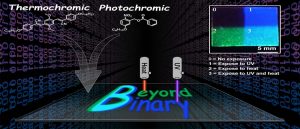R&D: Case Western Reserve University Researchers Find Chemical Solution Shrinks Digital Storage
To possibly store digital data in half space current systems require
This is a Press Release edited by StorageNewsletter.com on June 26, 2017 at 2:34 pmFrom Case Western Reserve University (CWRU)
Chemists at Case Western Reserve University have found a way to possibly store digital data in half the space current systems require.
CWRU chemistry researchers developed a space-saving method to store digital data optically, using four-symbol, or quaternary code. The four symbols are the absence of color and three colors – fluorescent green, ultramarine and cyan – produced when dyes contained in a common polymer are exposed to heat, ultraviolet light or both.
Click to enlarge
From supercomputers to smartphones, the amount of data people generate and collect continues to grow exponentially, and the need to store all that information grows with it.
Computers and other digital devices operate and store data using a binary code, meaning two symbols – typically the numerals 0 and 1 – represent information. To reduce storage space, engineers have traditionally used existing technology but made it smaller.
For example, a compact disc is made with a red laser and a Blu-ray disc with a blue, more focused, laser that reduces the size of the symbols and the space between them, increasing data density.
But according to a new study published in the Journal of Materials Chemistry C, researchers at CWRU demonstrate how commonly used polymer films containing two dyes can optically store data in a quaternary (four-symbol) code, potentially requiring about half as much space.
“We’re using chemistry instead of engineering to address data storage, but it’s really complementary to what engineers are doing,” said Emily Pentzer, assistant professor of chemistry, CWRU and study author. She worked with PhD students Peiran Wei and Bowen Li and Research Assistant Al de Leon on the project.
How it works
To take advantage of the quaternary storage, computer programs would need to be written in quaternary code instead of binary code, which Pentzer said would be easy with the system they used.
Instead of numerals, the optical-storage system uses the absence of color and three colors produced by the dyes as the symbols representing information.
The study
The researchers loaded a small amount – less than .4% by weight – of the two dye molecules into a flexible sheet of poly(methyl methacrylate), a polymer film called PMMA. PMMA is clear and colorless in ambient light and temperature.
One dye, cyano-substituted oligo(p-phenyene vinylene) fluoresces green when exposed to heat. The second dye, o-nitrobenzyl ester of benzoic acid, fluoresces ultramarine when exposed to ultraviolet light. When the overlapping dyes are exposed to both heat and UV light, they fluoresce as cyan.
Pentzer’s team wrote code by laying metal or wood templates over the dye-containing film, then applying heat and ultraviolet light. They cut their templates and applied code using facilities at Case Western Reserve’s Larry Sears and Sally Zlotnick Sears think[box].
Results and next steps
The circular symbols in the template were each 300μm across, with 200μm between them. The code proved durable, remaining legible even after the film had been rolled, bent, written on with permanent marker, submerged in boiling water and half the surface had been rubbed away with sandpaper.
The team is now investigating the use of specialized lasers to shrink the spatial resolution and therefore increase the data density (think CD vs. Blu-ray).
They are also investigating whether a third dye can be added that responds to different stimuli and remains distinct from the other two. If so, the colorless film, plus all the color combinations available, would allow the research team to store data using a septenary, or seven-symbol code, further shrinking storage.
Article: Beyond binary: optical data storage with 0, 1, 2, and 3 in polymer films
Journal of Materials Chemistry C has published an article written by Peiran Wei, Bowen Li, Al de Leon and Emily Pentzer, Department of Chemistry, CWRU, Cleveland, USA .
Abstract: “The evergrowing amount of data created and collected is met with the increased need to store this data. In compliment to improving data storage capabilities using engineering controls such as decreased pixel size (i.e., Blu-ray) or 3-D pixels (i.e., voxels), chemistry-based approaches are required to move beyond current limitations and meet our future needs. Herein, we present a new methodology to optically store data in a quaternary code of 0, 1, 2, 3 in a commodity polymer containing a low loading of two small molecules, and using heat and UV light to write, and read fluorescence output. The as-prepared film is non-fluorescent (0), and can be written through a wooden or metal mask with thermal treatment (1), light treatment (2), or both (3), giving three different colours of fluorescence under UV irradiation. The flexible polymer film remains colourless and transparent under ambient light after patterning, retains the stored data after exfoliation with sandpaper, and can be removed from the substrate and mechanically deformed without detriment to the pattern. This straightforward and scalable system demonstrates the use of simple and robust chemical reactions to improve data storage capabilities and has the potential to exponentially increase information density.”
















 Subscribe to our free daily newsletter
Subscribe to our free daily newsletter

